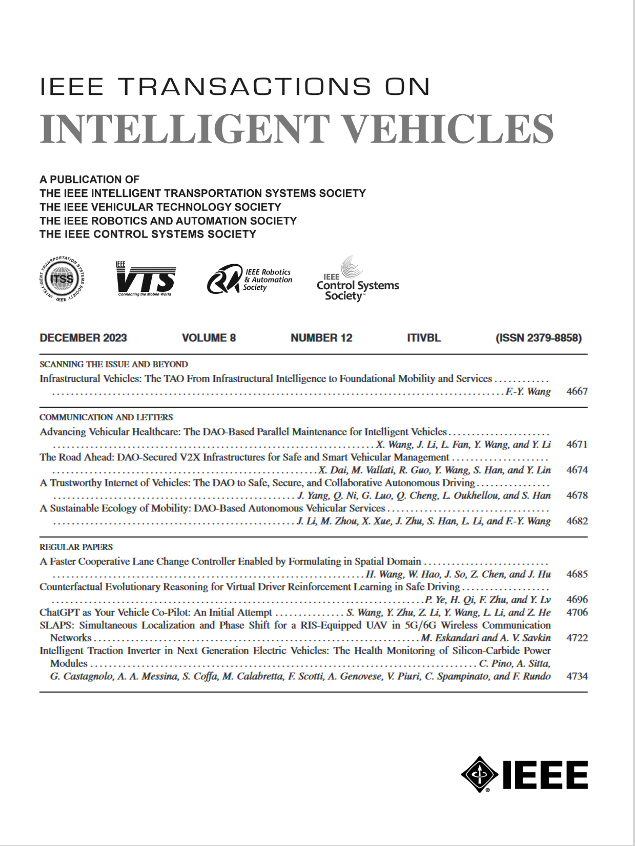基于V2V通信的混合交通流自动驾驶控制
IF 14.3
1区 工程技术
Q1 COMPUTER SCIENCE, ARTIFICIAL INTELLIGENCE
引用次数: 0
摘要
自动驾驶汽车(AVs)有望改变智能交通系统的未来。为了提高自动驾驶汽车与人类驾驶汽车(HDVs)整合的可行性,自动驾驶技术需要准确评估驾驶情况,并在人类期望的范围内运行。汽车跟随(CF)和变道(LC)是提高自动驾驶汽车控制性能的关键模型。然而,大多数CF和LC模型是单独开发的,并在少数车辆样本上进行测试,没有考虑它们对交通流的影响。因此,本研究开发了一种同时生成CF和LC决策的自动驾驶控制模型。该模型利用了车对车(V2V)技术,该技术结合了34个来自主题车辆和6个周围车辆的特征。提出了一种基于LSTM的混合深度学习模型,该模型具有两个并行结构。通过应用NGSIM数据集,该模型在加速度、速度和位置水平上的匹配准确率分别为70.5%、96.1%和98.4%,优于其他所有模型。进行了交通流模拟,验证了车辆在人类预期范围内的驾驶行为,并且模拟对于描述实际交通流是可靠的。为了舒适和安全驾驶,自动驾驶汽车的加速变化率被限制在一定的范围内。随着AV率的增加,交通拥堵得到缓解,速度从47.5 km/h增加到74.9 km/h,密度从36.8 veh/km降低到25.4 veh/km。然而,除非达到100%,否则交通安全仍然不稳定。本研究为混合交通场景下基于v2v的自动驾驶控制的发展做出了贡献。本文章由计算机程序翻译,如有差异,请以英文原文为准。
Automated Driving Control in Mixed Traffic Flow Using V2V Communication
Automated vehicles (AVs) are expected to transform the future of intelligent transportation systems. To enhance the feasibility of integrating AVs with human-driven vehicles (HDVs), AV technology needs to accurately assess driving situations and operate within human expectations. Car-following (CF) and lane-changing (LC) are key models for improving AV driving control. However, most CF and LC models were developed separately and tested on a few vehicle samples, without considering their impacts on traffic flow. Therefore, this study develops an automated driving control model that simultaneously generates CF and LC decisions. The model utilizes vehicle-to-vehicle (V2V) technology that incorporates thirty-four features from the subject vehicle and six surrounding vehicles. A hybrid deep learning model is proposed using LSTM with two parallel structures for each maneuver. By applying the NGSIM dataset, the proposed model outperformed all other models with the accuracy of matching ratios of 70.5%, 96.1%, and 98.4% at acceleration, speed, and position levels, respectively. Traffic flow simulations were conducted, validating that vehicles perform driving behaviors within human expectations and the simulations are reliable for describing the actual traffic flow. For comfort and safe AV driving, jerk, or change rate of acceleration, is restricted within a certain range. With the AV rate increasing, traffic congestion was mitigated with speed increasing from 47.5 to 74.9 km/h and density decreasing from 36.8 to 25.4 veh/km. However, traffic safety remained unstable unless the rate reached 100%. This study contributes to the development of V2V-based AV driving control in mixed traffic scenarios.
求助全文
通过发布文献求助,成功后即可免费获取论文全文。
去求助
来源期刊

IEEE Transactions on Intelligent Vehicles
Mathematics-Control and Optimization
CiteScore
12.10
自引率
13.40%
发文量
177
期刊介绍:
The IEEE Transactions on Intelligent Vehicles (T-IV) is a premier platform for publishing peer-reviewed articles that present innovative research concepts, application results, significant theoretical findings, and application case studies in the field of intelligent vehicles. With a particular emphasis on automated vehicles within roadway environments, T-IV aims to raise awareness of pressing research and application challenges.
Our focus is on providing critical information to the intelligent vehicle community, serving as a dissemination vehicle for IEEE ITS Society members and others interested in learning about the state-of-the-art developments and progress in research and applications related to intelligent vehicles. Join us in advancing knowledge and innovation in this dynamic field.
 求助内容:
求助内容: 应助结果提醒方式:
应助结果提醒方式:


